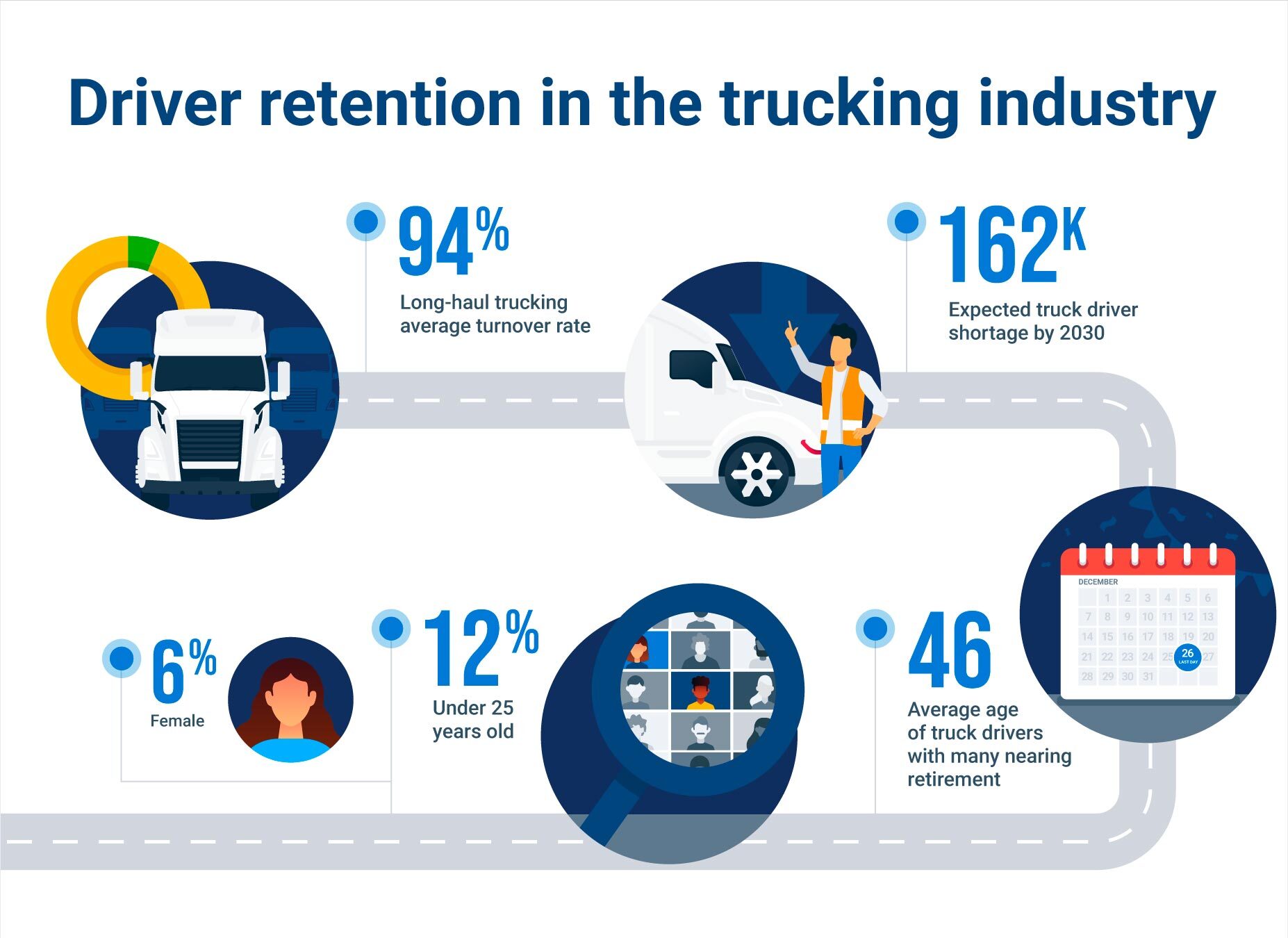Win the truck driver retention battle with technology
Learn how telematics and modern fleet management solutions can address the trucking industry's driver retention challenges. This blog highlights the role of technology in improving driver satisfaction, safety and operational efficiency.
By Geotab Team
Aug 26, 2025
.jpg)
Key Insights
- Driver turnover crisis: The trucking industry faces a 94% turnover rate, with a projected shortage of 162,000 drivers by 2030, driven by an aging workforce and underrepresentation of younger drivers and women.
- Telematics solutions: Technology like automated compliance, real-time alerts and driver scorecards enhances safety, simplifies workflows and improves driver satisfaction.
- Proven impact: Companies using telematics have reported better driver behavior, streamlined operations and increased retention showcasing the tangible benefits of a driver-first approach.
The trucking industry faces a persistent challenge retaining top driving talent. With driver shortages putting strain on operations, attracting and keeping skilled drivers has never been more crucial.
The scope of the issue is staggering: the average turnover rate for long-haul trucking is approximately 94%, and nearly 40% of truckers say they are actively looking for a new job. According to American Trucking Associations the average driver age is 46, with only 12% of drivers under 25, raising concerns about the aging workforce and highlighting recruitment difficulties for younger generations and underrepresented groups like females. Driver job satisfaction also ranks in the bottom 10% of all careers, with key concerns including compensation, work-life balance and career longevity.
Beyond competitive pay, drivers value safety, efficiency and support in their day-to-day roles. By simplifying workflows, enhancing safety and improving the overall driver experience, telematics-enabled fleet management solutions can transform driver retention strategies and position your company as one that puts its drivers first.

Leverage telematics for a driver-centric approach
Picture your drivers being able to start their day with an intuitive in-cab app that provides route information, pre-trip inspections and automated HOS logs at their fingertips. Throughout the day, real-time alerts warn them of heavy traffic or unsafe weather conditions ahead, allowing them to adjust routes proactively. Cameras and scorecards provide feedback to enhance their driving skills, while automated compliance tracking reinforces adherence to regulations. This seamless experience eliminates frustrations, improves safety and empowers drivers to focus on the road.
Modern fleet management tools redefine the driver experience by simplifying day-to-day tasks and boosting compliance without added stress. They help fleets not only attract talent but also create work environments where drivers want to stay long-term. With over 3.55 million professional drivers in the U.S., many nearing retirement, innovative solutions are vital to reverse industry trends where the shortage is projected to reach 162,000 drivers by 2030.
By investing in the following, you can demonstrate an understanding of driver needs, as well as foster morale and satisfaction.
ELD automation | Safety scorecards and integrated cameras | Workflow efficiencies | Connected ecosystem |
| A simple yet powerful ELD solution automates compliance requirements, saving drivers time and reducing errors. | These tools provide actionable insights to improve driver behavior while reinforcing a strong safety culture. | From dispatch communications to route planning, integrated tools streamline operations and make life on the road much easier.
| An open platform and extensive partner network will allow fleets to customize solutions that align with your drivers’ unique needs. |
5 ways technology empowers truck drivers
1. Enhance driver safety and well-being
With safety being a top priority for drivers, AI-enabled dash cameras and telematics solutions promote safer driving through real-time feedback and proactive accident prevention. For example, cameras can alert drivers to potential hazards, while telematics data provides insights into risky behaviors like harsh braking or speeding. These technologies instill confidence among drivers, demonstrating the fleet’s commitment to their safety and well-being.
2. Streamline operations and reduce driver burden
Managing hours of service (HOS) logs, compliance paperwork and dispatch messaging can overwhelm drivers. You can simplify these tasks with solutions like automated ELD logs, intuitive workflows and integrated communication systems. By reducing administrative burdens, drivers can focus on driving safely and effectively.
3. Maximize driver earnings and uptime
Unplanned breakdowns and long idle times can disrupt a driver’s earning potential. Through predictive maintenance capabilities and fuel efficiency optimization you can reduce downtime, enabling drivers to maximize their time on the road. Knowing their livelihood is supported builds trust and loyalty between drivers and fleets.
4. Support training and skill development
Telematics isn’t just about tracking behavior – it’s a powerful tool for enabling driver coaching by analyzing data on performance indicators such as fuel efficiency and safe driving practices. Tailored training based on this data helps drivers improve their skills, boosting confidence and job satisfaction.
5. Optimize compensation and incentives
Using performance data, fleets can create transparent and fair compensation programs. Through telematic-driven insights managers can track operator scorecards and offer incentives for safe and efficient driving. These individualized performance-based rewards make drivers feel recognized and motivated.
Real-world impact on driver satisfaction and performance
Geotab solutions have already made a tangible difference for many fleets. Companies like Northern Logistics and Plastic Express have reported improvements in driver behavior, operational efficiency and overall satisfaction.
28% boost in driver performance
Northern Logistics leveraged driver scorecards to reward safe driving, fostering a culture of mutual respect and acknowledgment
13% decrease in severe alerts
Plastic Express streamlined compliance processes to make daily workflows easier for drivers.
These examples underscore how technology can bridge the gap between driver retention goals and real-world outcomes.
Win the retention battle by putting drivers first
Drivers are the backbone of the trucking industry. By investing in their safety, streamlining their workflows and ensuring their needs are met, fleets can foster loyalty and long-term success.
Geotab’s open platform, customizable solutions and commitment to continuous improvement not only helps you prioritize your drivers. By utilizing innovation to tackle the root causes of driver turnover, like job dissatisfaction, compliance stress and unsafe conditions, Geotab can help you win the driver retention battle. Discover how Geotab not only enhances the driver experience but also future-proofs your operations with leading-edge technology and actionable insights.
Subscribe to get industry tips and insights
The Geotab Team write about company news.
Table of Contents
Subscribe to get industry tips and insights
Related posts

The $4B Crisis: Video Intelligence as the Answer to Fleet Distraction
December 2, 2025
3 minute read

The True Cost of Cargo Theft: When Customer Trust is on the Line
November 24, 2025
2 minute read

Telematics device cost: Key factors that determine pricing
November 19, 2025
5 minute read

Law enforcement technology: Four trends to know for 2026
November 7, 2025
6 minute read

Four seasons of fleet intelligence with Geotab's Public Works solution
November 7, 2025
2 minute read

Infographic: What are the ripple effects of school bus driver turnover?
November 6, 2025
1 minute read